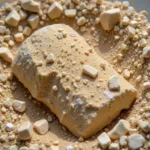The human brain, the command center of our bodies, is often depicted in shades of gray. But what color is the brain, really? The answer is more nuanced than you might think and involves understanding the living, pulsating organ in its natural state, as opposed to the preserved specimens we often see in educational settings.
Unraveling the Brain’s True Colors
The color of a living, healthy human brain is a pinkish-beige, primarily due to the extensive network of blood vessels that supply it with oxygen and nutrients. This coloration is often obscured in preserved brains, which are typically treated with formaldehyde and other chemicals, leading to the grayish hue we commonly associate with the organ. The color can also vary slightly depending on the area of the brain and the individual. Understanding what color is your brain requires looking beyond the preserved specimens and considering its living, dynamic nature.
The Role of Blood Flow in Brain Color
Blood is essential for brain function, constantly delivering oxygen and glucose while removing waste products. The rich network of capillaries and larger vessels contributes significantly to the brain’s pinkish appearance. This coloration is most prominent on the surface, where the blood vessels are more concentrated.
Beyond Pink: The Shades of Gray Matter and White Matter
While the overall color of a living brain is pinkish-beige, it’s important to understand the distinction between gray matter and white matter. Gray matter, responsible for processing information, contains a high concentration of neuronal cell bodies, giving it a darker gray appearance. White matter, which connects different regions of the brain, consists primarily of myelinated axons, which appear lighter in color due to the fatty myelin sheath. Knowing what color is a brain involves recognizing the interplay of these different tissues and the overall blood supply.
Why Preserved Brains Appear Gray
Preserved brains often undergo a process that involves fixatives like formaldehyde. These chemicals alter the brain’s structure and color, causing the pinkish hue to fade and leaving behind a dull gray. This is why museum specimens and educational materials often depict the brain in shades of gray. What is the color of your brain in its living state is markedly different from these preserved examples.
What Color Ribbon for Brain Cancer?
The awareness ribbon for brain cancer is gray. This color represents the gray matter of the brain and serves as a symbol of support for those affected by this disease. You can learn more about this by visiting what is the color ribbon for brain cancer. What color ribbon for brain cancer represents solidarity and hope for advancements in research and treatment.
Conclusion
So, what color is the brain? While often depicted as gray, a healthy, living brain is actually a vibrant pinkish-beige due to its rich blood supply. Understanding the different components of the brain and the effects of preservation techniques helps us appreciate the complexity and dynamism of this vital organ.
FAQ
- What causes the brain to be pink? The extensive network of blood vessels supplying the brain with oxygen contributes to its pinkish hue.
- Why are preserved brains gray? Preservatives like formaldehyde alter the brain’s color and structure, resulting in a grayish appearance.
- What is the difference in color between gray matter and white matter? Gray matter appears darker gray due to the concentration of neuronal cell bodies, while white matter is lighter due to the myelin sheath.
- What is the significance of the gray ribbon? The gray ribbon symbolizes brain cancer awareness and support for those affected.
- Where can I find more information on the color ribbon for brain cancer? You can learn more at what color is the color ribbon for brain cancer.
- Does the brain’s color change after death? Yes, the brain’s color shifts from pinkish-beige to gray after death due to the cessation of blood flow and the effects of decomposition.
- Are there any variations in brain color among individuals? While the general color is pinkish-beige, slight variations can occur due to individual differences in blood flow and tissue composition.
Need support? Contact us 24/7 at Phone Number: 0373298888, Email: [email protected], or visit us at 86 Cau Giay, Hanoi.
